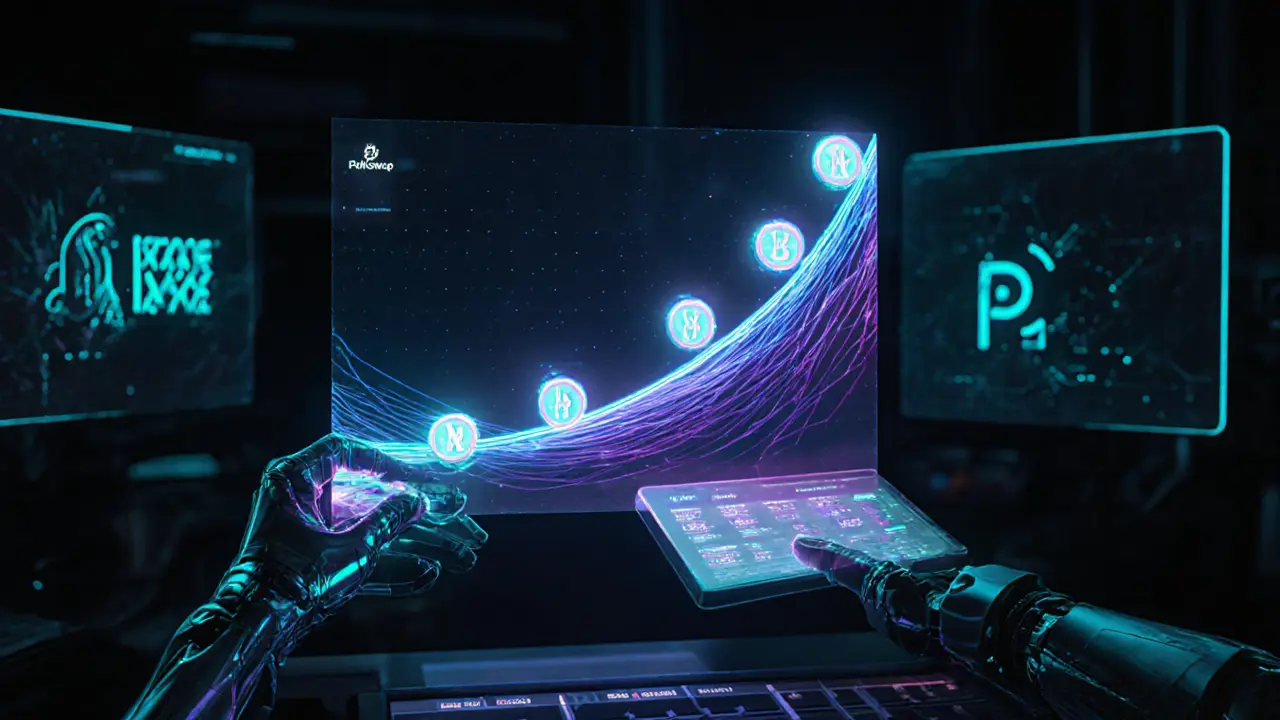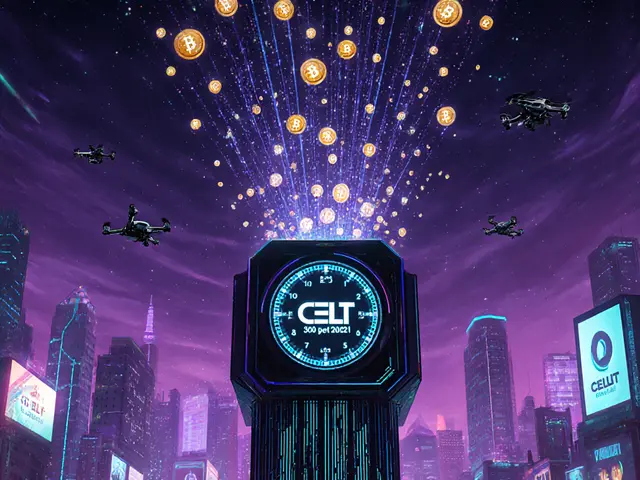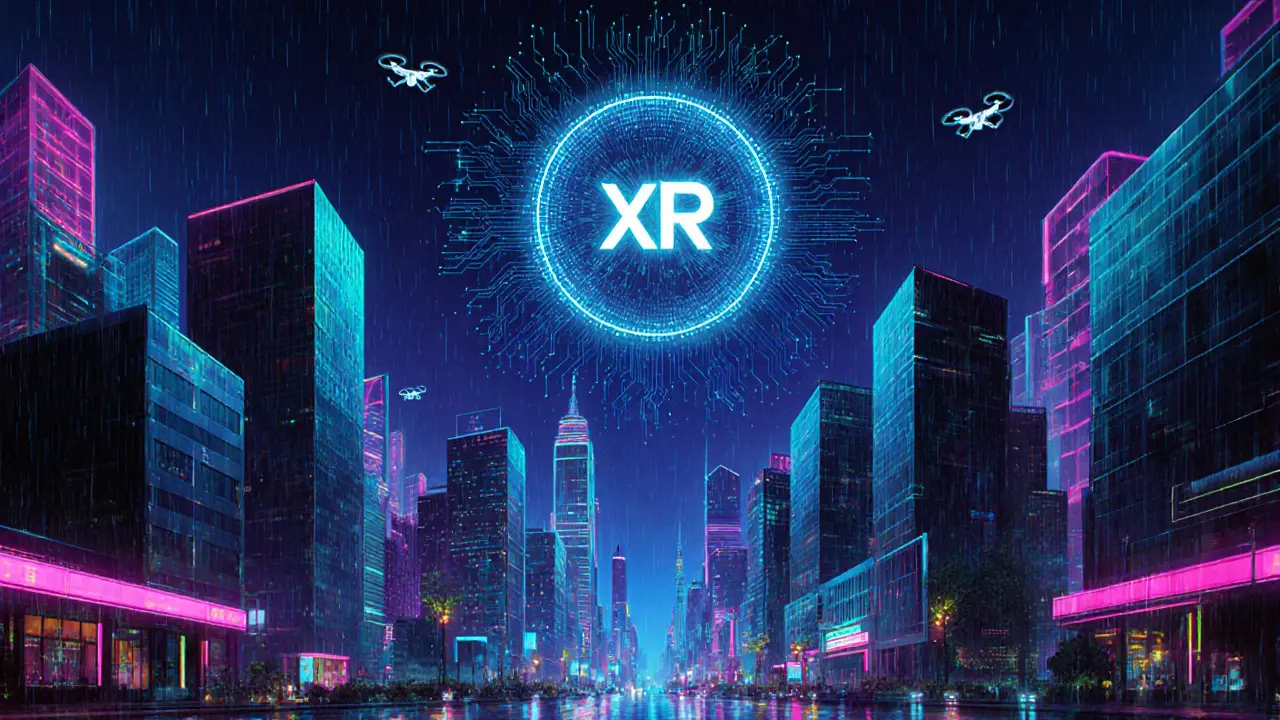XOR Bonding Curve Calculator
How the XOR Bonding Curve Works
When you buy XOR, the price increases as supply expands. When you sell, the price decreases as supply contracts. This creates an elastic money supply without central control.
Current price: $0.00000014 per XOR (based on article data)
Results
Current Price: $0.00000014
New Supply: 1,000,000 XOR
Estimated Cost: $0.00000014
Price Change: 0.00%
This calculator uses a simplified bonding curve model based on SORA's token economics. Actual transactions may vary based on market conditions.
Ever heard of a crypto that tries to replace whole national monetary systems? That’s the bold claim behind SORA XOR. Launched in 2019, SORA is both an economic framework and a native utility token (XOR) that lives on a high‑speed, low‑cost blockchain built with Substrate - the same modular engine that powers Polkadot. In this guide we’ll unpack what SORA actually does, how the XOR token works, why its tech matters, and what you need to know before you consider buying or building on it.
What Is SORA?
SORA (pronounced "sora" like the Japanese word for sky) is a decentralized economic system created by Sora Labs, a Tokyo‑based research group that also runs the development arm Soramitsu Co., Ltd.. The core idea is simple: build a global, debt‑free monetary network where money supply can expand or shrink automatically based on demand, without a central bank pulling the strings.
How Does the XOR Token Work?
XOR is the native utility token of the SORA network. It isn’t mined; instead, it is minted and burned through a token bonding curve - a mathematical formula that sets a price for every new token created and determines how many tokens are destroyed when someone sells back to the curve. This mechanism gives XOR an elastic supply, meaning the total amount of coins can flex to match the size of the economy using it.
- Buy‑price function: When you deposit a base currency (e.g., DOT or USDT) into the curve, the price rises gradually as supply increases.
- Sell‑price function: Selling XOR back to the curve pushes the price down, burning the tokens you return.
- Predictable liquidity: Because the curve always offers a price, there’s never a sudden “order‑book gap” that can stall trades.
The bonding curve also serves as an automated market maker for the Polkaswap DEX, which launched in 2021 and runs natively on SORA. Polkaswap lets users swap XOR for other assets without relying on traditional order books.
Technical Foundations
Under the hood, SORA is a Polkadot parachain. Being a parachain means it inherits Polkadot’s shared security model and can seamlessly communicate with any other parachain or the main relay chain. This cross‑chain ability is a big plus for developers who want to move assets between ecosystems without bridges that often become hack targets.
Performance numbers are impressive: SORA v3 can handle up to 6,000 transactions per second (tps) with a block time of about three seconds. Transaction fees are just a few cents - a stark contrast to Bitcoin’s 15‑minute confirmation window and multi‑dollar fees.
Because Substrate is a proof‑of‑stake (PoS) based platform, SORA’s energy consumption is tiny compared with proof‑of‑work (PoW) networks. The network runs on validator nodes that stake DOT to secure the chain, keeping the carbon footprint lower than many nations.

Tokenomics and Governance
At launch, SORA allocated a massive supply of 12.62 quadrillion XOR. While the sheer number looks scary, the bonding curve means the effective circulating supply is whatever users have minted through the curve. Governance is baked into the protocol: XOR holders can submit proposals, vote on upgrades, fund community projects, or even decide on new token‑issuance parameters.
Recent community decisions have funded over $15 million in blockchain school initiatives, showing the “non‑debt‑based” funding model in action. The voting process uses a simple majority rule, with voting power proportional to the amount of XOR staked.
How to Acquire XOR
If you’re ready to get your hands on XOR, the primary liquidity source is Uniswap V3 on the Ethereum network. Here’s a quick step‑by‑step:
- Set up a Web3 wallet (MetaMask, Trust Wallet, etc.) and fund it with ETH.
- Navigate to the Uniswap V3 interface and paste the XOR contract address (0x... - see SORA’s official docs).
- Swap ETH for XOR. The bonding curve will determine the exact price you pay.
- If you prefer lower gas fees, bridge the XOR to the SORA parachain using the official bridge tool, then trade on Polkaswap.
For newcomers, the steep learning curve around bonding curves can be confusing. Take advantage of community tutorials on the SORA Discord and the developer portal on sora.org.
Pros and Cons - A Quick Comparison
| Feature | SORA (XOR) | Bitcoin | Ethereum |
|---|---|---|---|
| Consensus | Proof‑of‑Stake (Polkadot) | Proof‑of‑Work | Proof‑of‑Stake (post‑Merge) |
| Tx/sec | ~6,000 | ~7 | ~30‑45 |
| Avg. fee | ¢ 0.01‑0.05 | $10‑$50 | $0.50‑$2.00 |
| Energy use | Low (PoS) | Very high (PoW) | Moderate (PoS) |
| Supply model | Elastic bonding curve | Fixed 21 M | Inflationary (≈4.5%/yr) |
From the table you can see SORA’s biggest strengths are speed, cheap fees, and an adaptive money supply. The main drawback is its tiny market cap and low retail awareness, which translates into limited liquidity on major exchanges.
Current Market Landscape
As of late 2023, XOR’s price hovered around $0.00000014, giving the network a market cap of roughly $1.8 million - far outside the top‑1000 crypto rankings. Most of the daily volume (about $4,000) sits on the XOR/WETH pair on Uniswap V3. The token’s enormous supply and minuscule price make it hard for casual investors to gauge value, but the design is intentionally aimed at macro‑level monetary use, not speculative trading.
Regulators haven’t singled out SORA, but because it operates as a parachain in the Polkadot ecosystem, it inherits Polkadot’s legal stance of being a decentralized protocol. That said, any future adoption as a national currency would still need to navigate each country’s financial‑services regulations.
Future Roadmap
SORA v3 is already live, but the team has big plans:
- Cross‑chain expansion: Deeper integration with other parachains (e.g., Kusama, Moonbeam) to enable seamless asset swaps.
- Enhanced governance tools: Quadratic voting and off‑chain referendum mechanisms to make community decisions more nuanced.
- Real‑world pilots: Ongoing talks with small economies to test XOR as a legal tender for limited services.
All of these moves aim to prove that an elastic, non‑debt monetary system can work at scale. Whether those pilots ever materialize will decide if SORA stays a tech curiosity or becomes a genuine alternative to fiat.
Key Takeaways
- SORA is a Polkadot parachain that uses a token bonding curve to create an elastic money supply.
- XOR transactions are fast (≈3 seconds) and cheap (cents), far outpacing Bitcoin and Ethereum.
- Governance is token‑based; holders fund projects and vote on protocol upgrades.
- Liquidity is limited to a few DEXs, mainly Uniswap V3 and Polkaswap.
- Future success hinges on gaining real‑world adoption beyond niche developer circles.
What is the purpose of the token bonding curve in SORA?
The bonding curve automatically sets buy and sell prices for XOR, allowing the token supply to expand when demand rises and contract when demand falls. This creates an elastic money supply without a central bank.
How does SORA achieve fast and cheap transactions?
SORA runs on Substrate as a Polkadot parachain, using a proof‑of‑stake validator set. The architecture processes up to 6,000 tps with ~3‑second block times, keeping fees at only a few cents.
Where can I buy XOR?
The main liquidity pool for XOR is the XOR/WETH pair on Uniswap V3 (Ethereum). You can also bridge XOR to the SORA parachain and trade on Polkaswap for lower gas fees.
Is SORA meant to replace fiat currencies?
The project’s long‑term goal is to provide a non‑debt‑based monetary system that governments could adopt. As of now, it remains a niche DeFi protocol without any national deployments.
What are the risks of investing in XOR?
Low market cap, limited exchange listings, and a very low token price mean price volatility can be extreme. Additionally, adoption depends on political decisions that are hard to predict.






Comments
12 Comments
Rampraveen Rani
XOR is wild bro 🤯 elastic money supply? no central bank? this is the future
Abby Gonzales Hoffman
I’ve been following SORA since 2021. The bonding curve is genius-it removes the gambling vibe of most cryptos. You’re not buying a token, you’re participating in a monetary experiment. And the fact that it’s built on Substrate? That’s the real win. Polkadot’s security + no gas wars = actual utility.
Prabhleen Bhatti
As someone from India, I find this fascinating-imagine a system where inflation isn’t a policy tool but a mathematical outcome. The 12.62 quadrillion supply looks absurd until you realize it’s not circulating-it’s theoretical. The real value is in the mechanism. And yes, it’s way more efficient than UPI for cross-border settlements. We need this in emerging economies.
Natasha Nelson
I... I don’t understand how the bonding curve works. I mean, if you buy 100 XOR, the price goes up? And then if you sell, it burns? So… you’re literally paying more to buy, and then losing value to sell? That’s… not how money works? I’m confused.
ashish ramani
The technical specs are impressive but the market cap is $1.8M. That’s a joke. No retail investor will touch this. It’s a lab experiment, not an investment.
Elizabeth Mitchell
I read the whole thing. Honestly? It feels like a really smart idea that nobody’s using. Like, if it’s so good, why is it buried on Uniswap V3? I’m not saying it’s a scam, but it’s definitely a cult project.
Richard Williams
Don’t sleep on this. Most people dismiss crypto projects because they don’t see the price pump. But SORA isn’t built for pumpers. It’s built for builders. The $15M in community-funded blockchain schools? That’s real impact. If you’re looking for the next Bitcoin, look elsewhere. But if you want to see what money could be? This is it.
Chris Houser
The fact that this runs on PoS and uses less energy than a toaster is huge. Africa needs this. Imagine a country with unstable currency using XOR for microtransactions, remittances, or even paying teachers. No banks, no middlemen. Just code and trust.
Ashley Cecil
I must point out that the article contains multiple grammatical inconsistencies: "a few cents - a stark contrast" lacks proper punctuation before the em dash, and "XOR" is inconsistently capitalized in some sections. Furthermore, the claim that it "can handle up to 6,000 tps" is unsubstantiated without citing the source of the benchmark. This undermines the credibility of the entire piece.
William Burns
Let’s be honest: this is a glorified academic paper dressed as a cryptocurrency. The bonding curve is a neat theoretical construct, but without institutional adoption or regulatory clarity, it’s just math on a blockchain. The fact that the price is $0.00000014 isn’t a feature-it’s a red flag. This isn’t innovation. It’s vanity.
John E Owren
I get why people are skeptical. But remember Ethereum in 2015? Or Solana in 2020? People called them useless too. SORA’s not trying to be the next meme coin. It’s trying to solve a problem that no one else is willing to touch: rethinking money itself. It’s slow. It’s quiet. But it’s real.
Sarah Hannay
I appreciate the depth of this analysis, but I must respectfully disagree with the assertion that SORA’s model is truly debt-free. The entire system relies on external capital inflows-DOT, USDT, ETH-to mint XOR. That’s not a free-floating currency; it’s a derivative of existing assets. The bonding curve merely redistributes risk, not eliminates it. Until XOR is backed by real economic output-not speculative liquidity-it remains a speculative instrument, not a monetary system.
Write a comment